When you see a brown spider crawling around your home or property, it’s easy to jump to conclusions and think it must be a recluse. But according to Texas Parks and Wildlife, there are 900 spider species in the state, and only two of those groups are venomous to humans. Most of the spiders you will come across are entirely harmless and likely do more good than harm. Use this guide as a handy tool to identify these common spiders in Texas.
Venomous Spiders in Texas
There are only two types of venomous spiders to humans in Texas: widows and recluses. Bites from these spiders can cause serious health effects and require immediate medical attention.
Black Widow
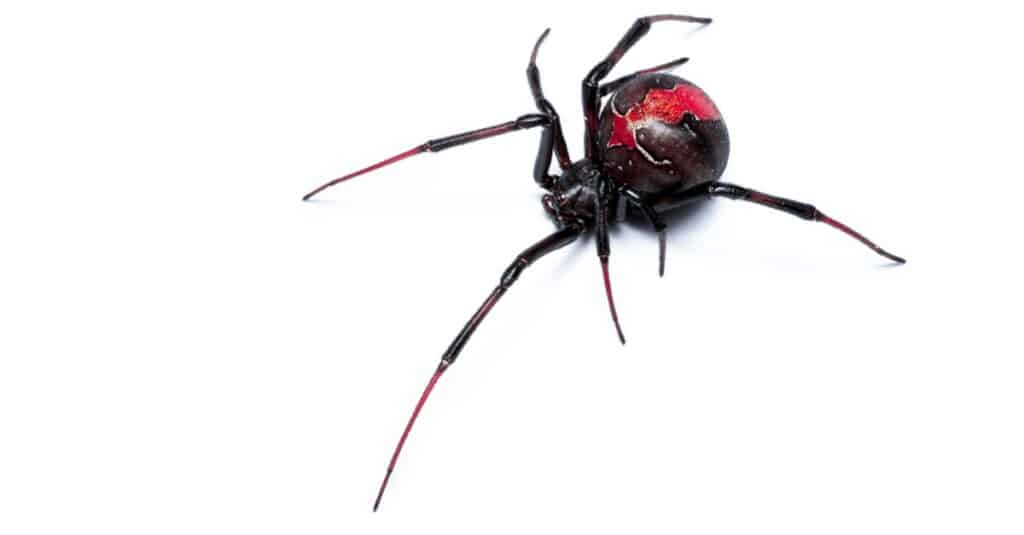
One of only two venomous spiders in Texas, black widows have a bright red hourglass shape on their abdomens.
©Steven Giles/Shutterstock.com
You can quickly identify a black widow by the bright red hourglass shape on their abdomens. This species has several variations, including the Northern, Southern, and Western black widows. However, they all have this distinctive marking and look very similar. Black widow venom is 15 times stronger than a rattlesnake’s and requires immediate medical care, especially for children and the elderly. You will often find this spider in woodpiles, boxes, under eaves, and other undisturbed areas.
Brown Widow

Brown widows have an orange hourglass shape marking.
©Decha Thapanya/Shutterstock.com
Brown widows are from the same widow family but have different coloration from black widows. The brown widow has a combination of tan and brown colors and black accents with an orange-colored hourglass marking. This species is not as venomous as the black widow but may require medical attention. They will also hide in similar areas as their relatives, typically in untouched places where they can be solitary.
Brown Recluse
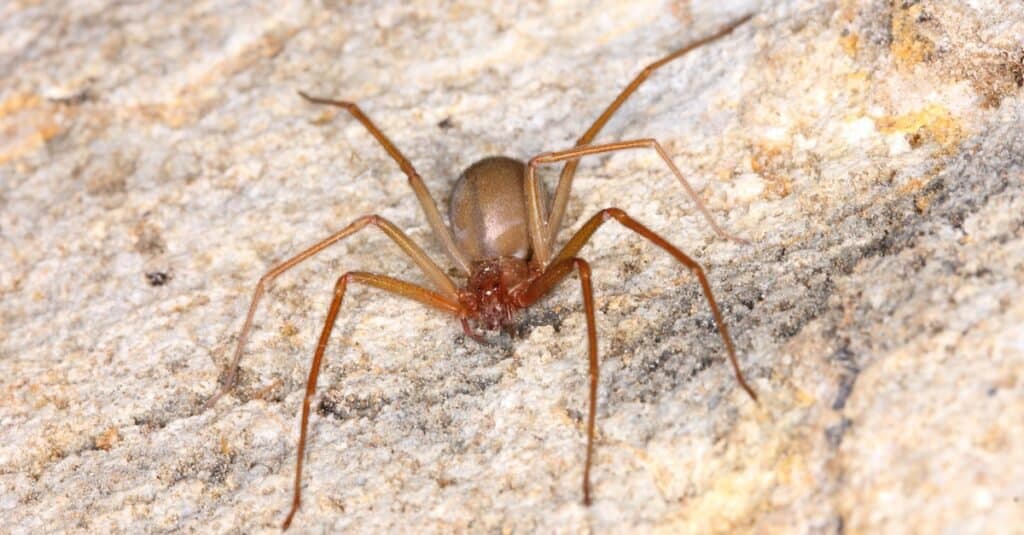
The brown recluse lives in basements and around gardens.
©Pong Wira/Shutterstock.com
The brown recluse is a little more challenging to identify as it resembles many other species. This spider has a sandy brown to darker brown color, six pairs of eyes, and occasionally will have a dark violin-shaped marking on its back. You will likely find a brown recluse in basements, under rocks, and around gardens. The recluse spider contains necrotic venom that can sometimes lead to medical care when a person is bitten.
Less Venomous Spiders That Bite
Most spider species are venomous, but only a few are harmful to humans. The spiders in this list are hostile to their prey and may cause a mild reaction in humans if bitten.
Northern Yellow Sac Spider
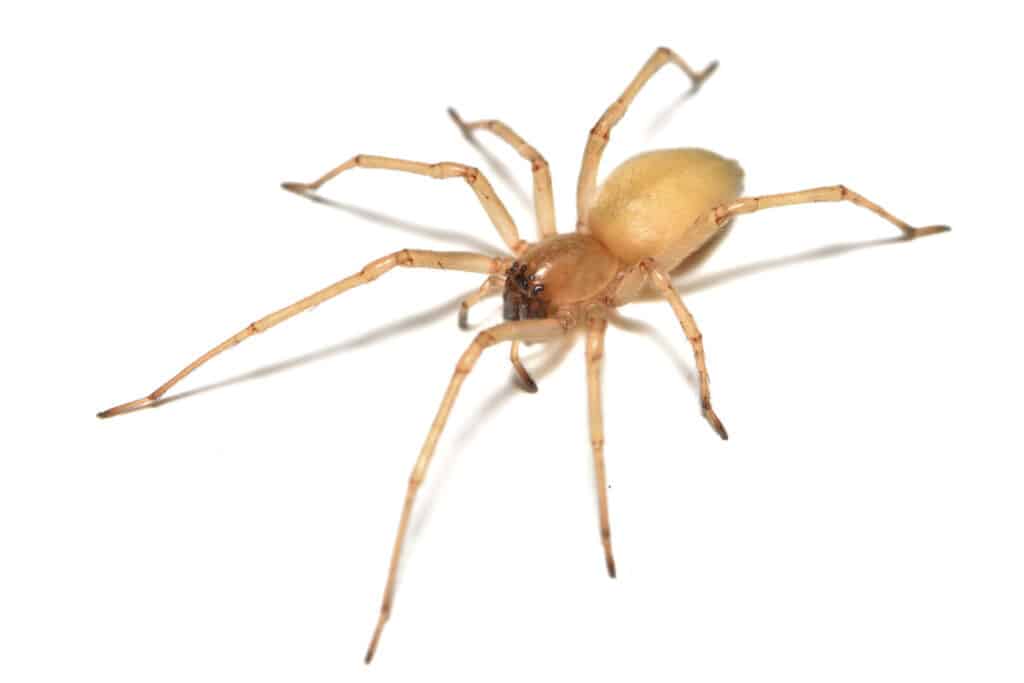
Yellow sac spiders account for more human bites than other species.
©Tobias Hauke/Shutterstock.com
This spider is a light yellow to cream color with a darker stripe running lengthwise across its abdomen. The yellow sac spider accounts for more human bites than any other species; however, the bites are relatively painless and mild for most. Human interactions with this spider are common because they inhabit foliage and leaf litter, typically where gardeners work.
Bold Jumping Spider

The daring jumping spider is a large species of jumping spider, but it rarely bites humans.
©iStock.com/JWJarrett
The bold jumping spider is black with white spots and stripes across its legs and abdomen. The most distinguishing characteristics are its front-facing eyes and green metallic mouthparts. While rare, this species of jumping spider may bite when provoked and can cause mild symptoms like redness, swelling, and itching for a couple of days. You can often find this spider around garden areas, fences, and exterior walls.
Eastern Parson Spider
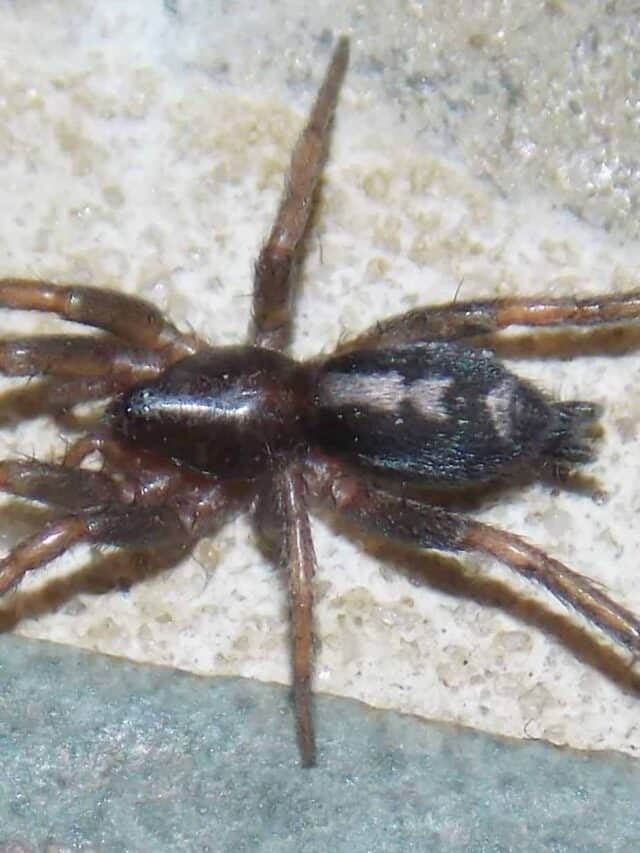
The parson spider is extremely fast and roams the ground at night.
©Fyn Kynd from Searsmont, Maine, United States / CC BY 2.0 – Original / License
The parson spider is hairy and is varying shades of brown from light to dark with a ruffled neck tie marking on its back. This nocturnal spider is extremely fast and prefers to roam the ground and walls, searching for its prey. During the day, it hides under rocks and other debris. Most people experience bites from this spider at night or when hiding in clothing. Typically, only mild allergic reactions occur.
Giant Spiders in Texas
These spiders are the biggest you will find in Texas. Tarantulas and wolf spiders can reach a leg span of up to four inches, making them the largest spiders in the state.
Fishing Spider
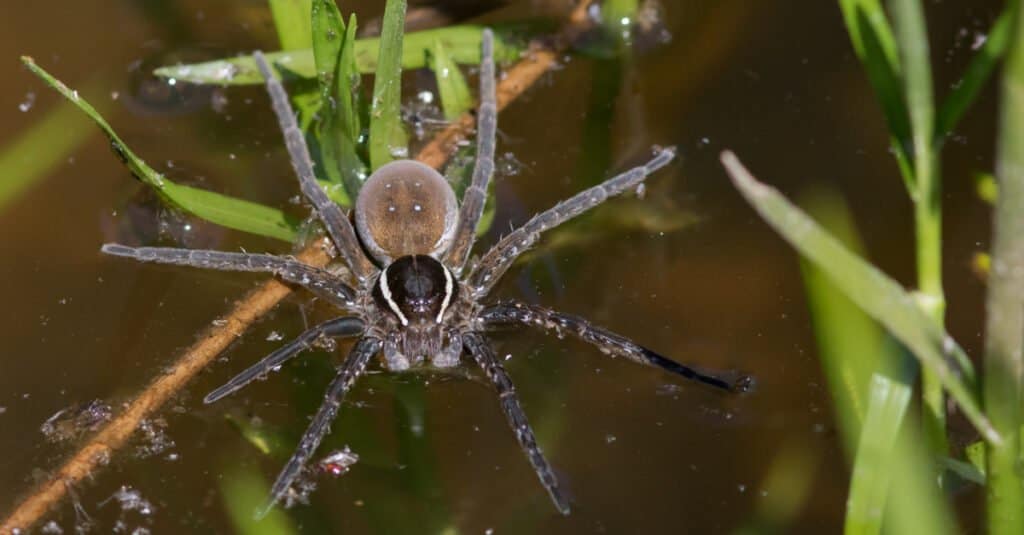
Fishing spiders wait by the edge of streams and pools for prey.
©Frode Jacobsen/Shutterstock.com
This semiaquatic species is dark brown with a striking pale stripe down each side of its body, which can grow up to three inches in length. To hunt, they wait by the edge of a pool or stream and run across the water’s surface when they feel ripples of nearby prey. They usually eat small insects, but some will feast on small fish. Fishing spiders frequently dwell in wooded areas and may find their way indoors.
Arizona Blonde Tarantula
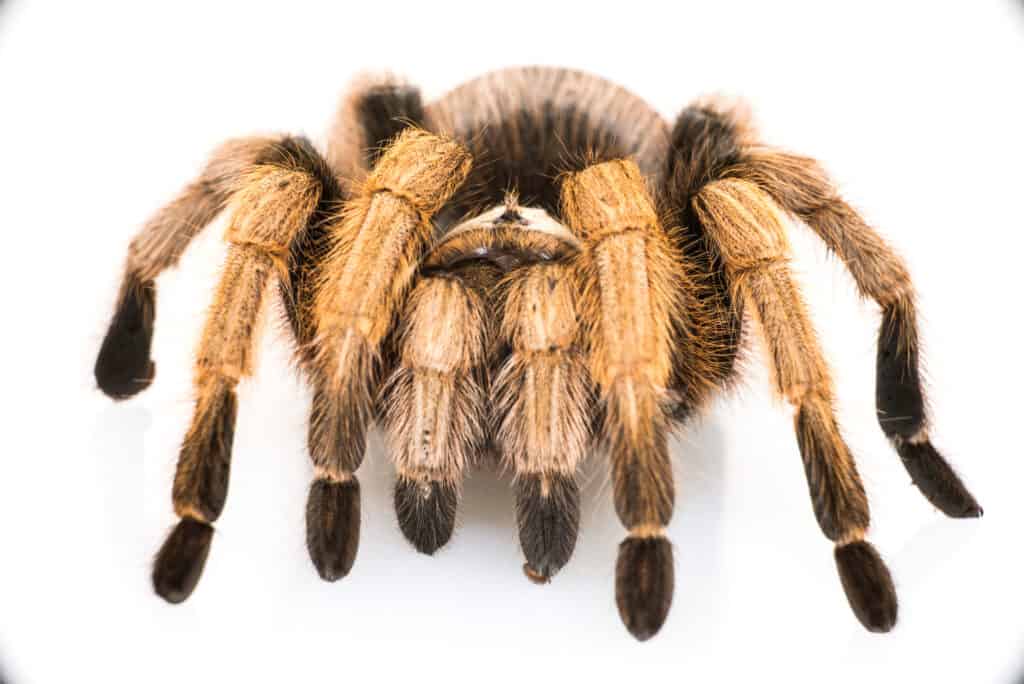
Blonde tarantulas are common in deserts during the summer rainy season.
©bloomphoto/Shutterstock.com
The blonde tarantula is a hairy, large-bodied spider, around three to four inches long. The females have a uniform tan color, while the males are copper colored with a reddish abdomen. These nocturnal spiders prefer to make their burrows in Southwest deserts. You will see them more often during the summer rainy season.
Texas Brown Tarantula

Texas brown tarantulas inhabit grasslands where they burrow underground.
©texas brown tarantula/Shutterstock.com
This tarantula species is slightly bigger, with a leg span over four inches and weighing up to three ounces. The Texas brown tarantula is the most common tarantula species in the Southern United States and is known for being rather docile. This terrestrial species inhabits grasslands, burrowing underground or using logs and abandoned dens as their homes.
Pantropical Huntsman
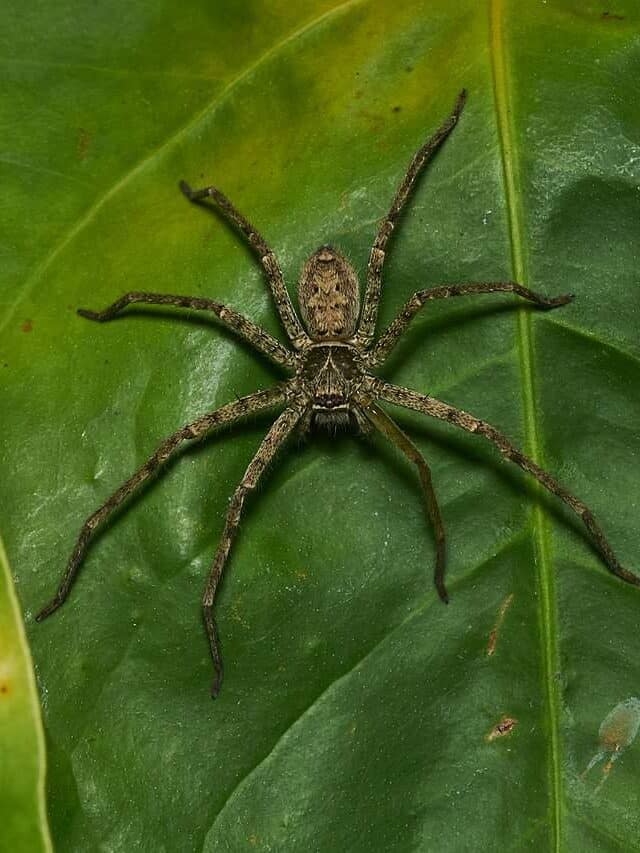
Pantropical huntsman spiders can measure nearly 12 centimeters long with their legs extended.
©© 2017 Jee & Rani Nature Photography / Jeevan Jose, Kerala, India / CC BY-SA 4.0 – Original / License
Pantropical huntsman spiders are large and primarily brown with long legs. The males are easier to spot because they have a dark (almost black) head with a v-shaped marking on their back. The females don’t typically have any distinctive coloring or markings. This huntsman spider can get up to three to five inches wide, and you will mainly find it inside logs and under loose bark on trees.
American Grass Spider
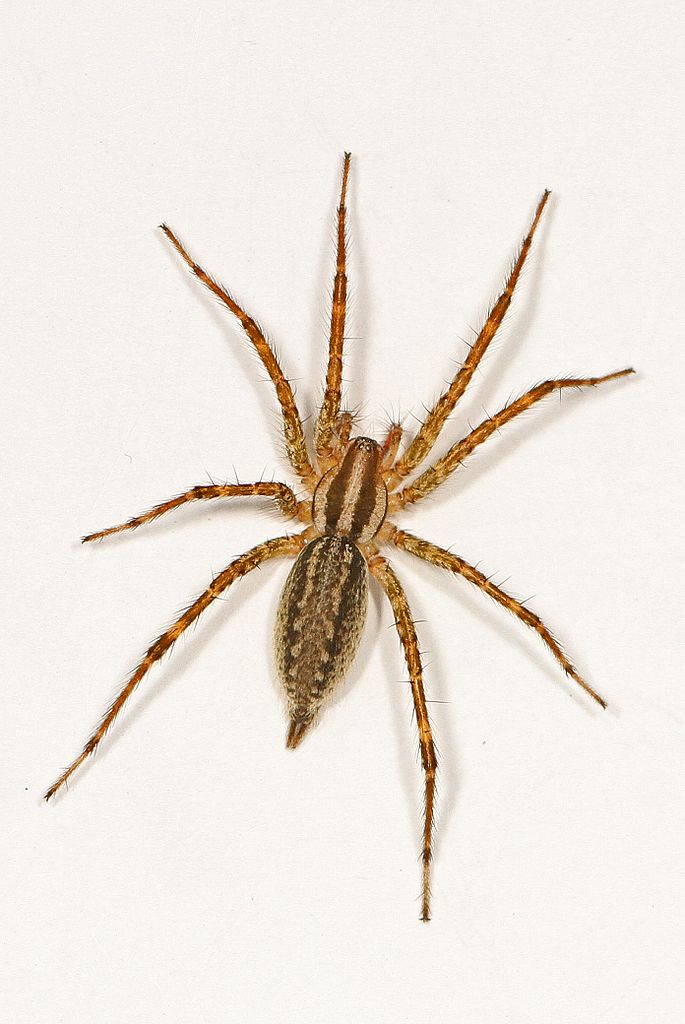
The harmless American grass spider spins their webs on grass and low-lying bushes.
Belonging to the family of funnel weavers, the grass spider is part of summers in North America due to the funnel-like webs they spin on grassy lawns. They have light to medium brown coloring with dark lines running from their eyes and down their back. You will likely find these harmless spiders in the grass and low-lying bushes.
Nursery Web Spider
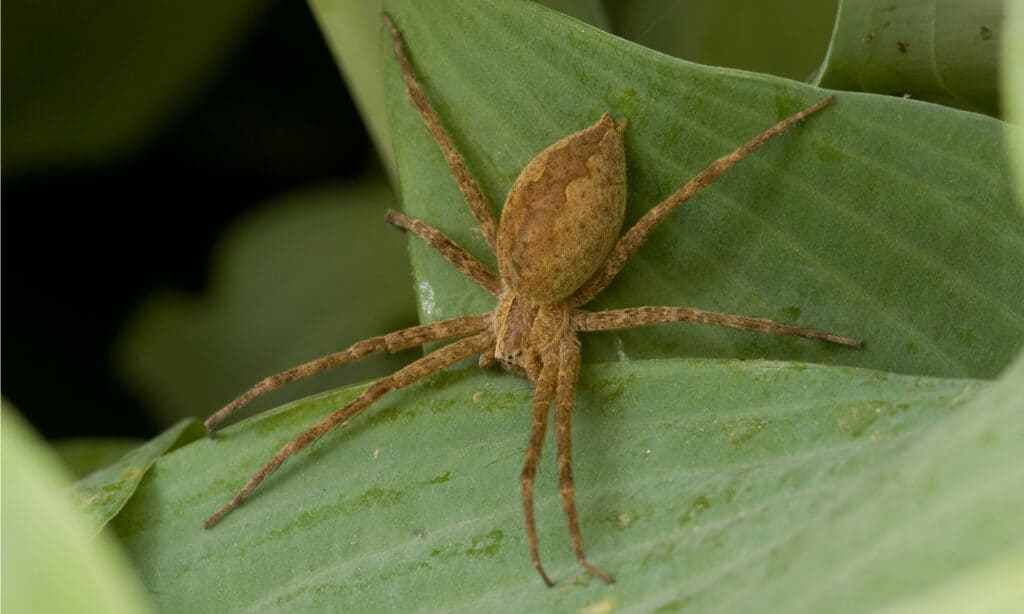
Nursery web spiders live in tall grass and shrubs.
©SDeming/Shutterstock.com
Females nursery web spiders construct tent-like structures (nurseries) to place their eggs inside, hence the name. Their brown coloring and large size make them look similar to wolf spiders, but one of the main differences is that nursery web spiders have eight eyes, all the same size. This spider lives in tall grass, shrubs, and along wooded edges.
Giant Crab Spider
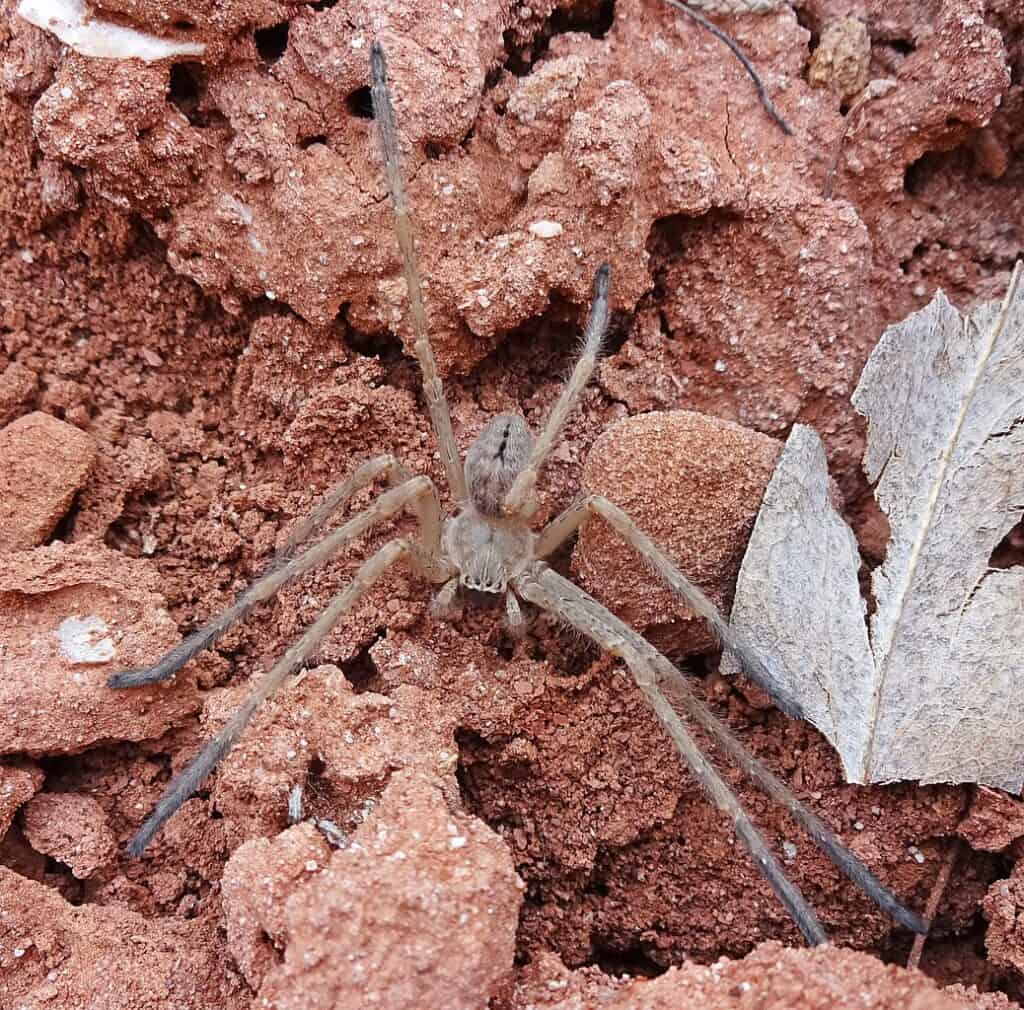
Giant crab spiders are aggressive, and their bite is more painful than a bee sting.
©Andrey Zharkikh from Salt Lake City, USA / CC BY 2.0, via Wikimedia Commons – Original / License
Giant crab spiders belong to the huntsman spider family but are much larger than other crab spiders, with a leg span of six inches. This crab spider is covered in tiny hairs, has tan coloring, and has a stretched y-shaped marking. They prefer warm, dry climates and like to hang out on trees, plants, and flowers. This species is reasonably aggressive, and its bite is more painful than a bee sting and can cause nausea and headaches.
Trapdoor Spider
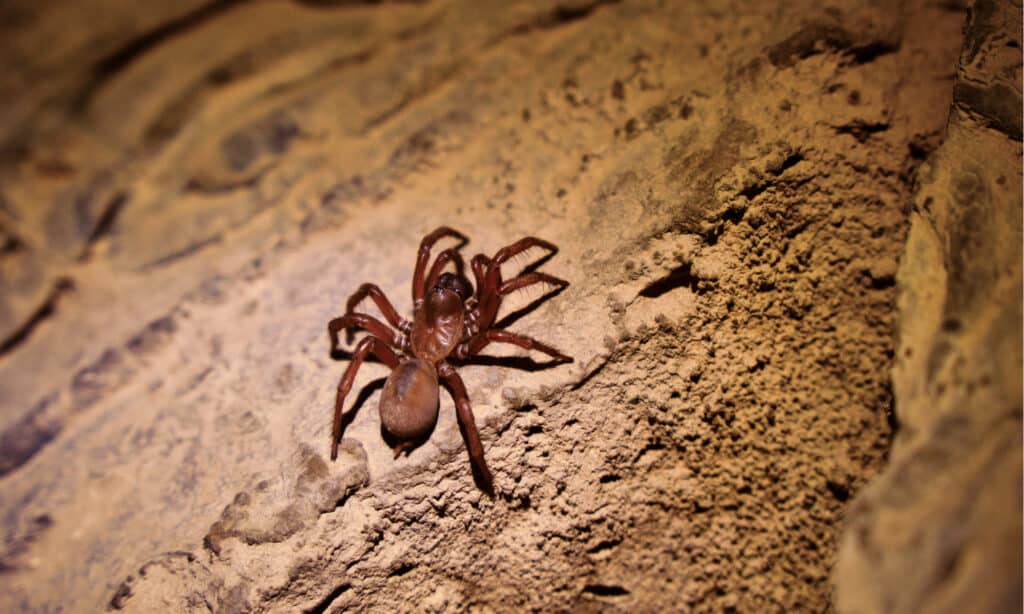
Trapdoor spiders are harmless but often mistaken for dangerous funnel web spiders.
©Geartooth Productions/Shutterstock.com
Trapdoor spiders, or unmidia, are a genus of spiders found worldwide. They are called trapdoor spiders because they build underground tunnels, which they secure with a trap door. They also live underground most of their lives, so you will have difficulty spotting one. Their colors range from dark brown to light reddish-brown and look similar to the Australian funnel web spider, which is dangerous to humans. But trapdoor spiders are harmless and non-threatening.
Wolf Spider
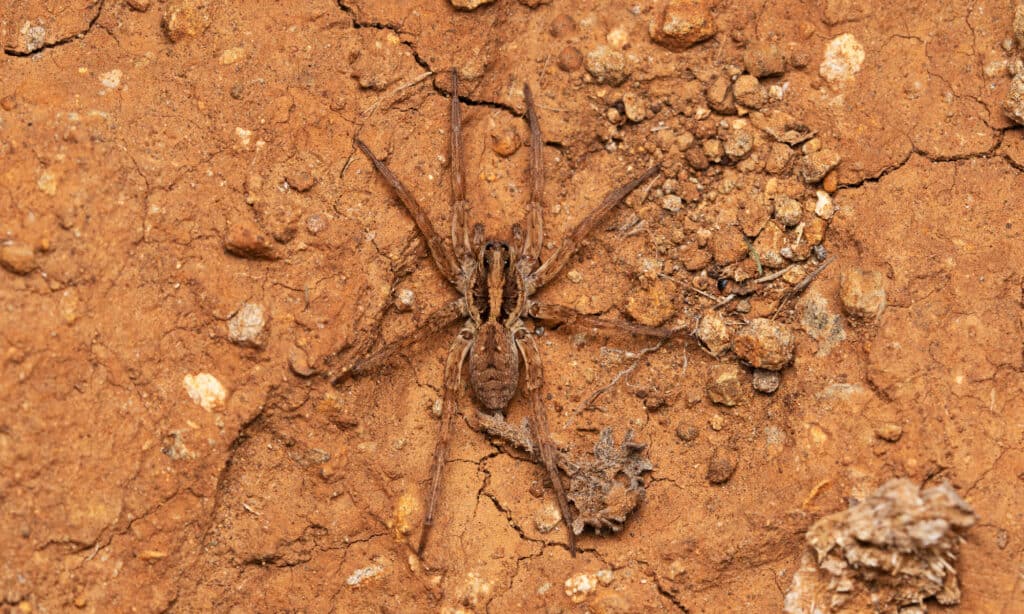
Wolf spiders live in open grasslands like farm fields and meadows.
©iStock.com/ePhotocorp
Wolf spiders look similar to nursery web and grass spiders but are distinguishable by their two large prominent eyes. This spider species lives in a multitude of habitats and will go where insects are abundant. However, you will often find them in grasslands like farm fields and meadows. These spiders will bite when provoked but only produce mild irritation.
Spiders That Live in Your Texas Home
House spiders thrive in indoor habitats, particularly if they are dark and dusty. Identifying spiders in your home is essential to know if you’re dealing with a dangerous species. Here are the most common house spiders in Texas.
Hacklemesh Weaver

The hacklemesh weaver has a distinctive chevron marking on its back.
©Eric Isselee/Shutterstock.com
The hacklemesh weaver is a deep mahogany brown with a unique chevron-style marking on its back. This spider will hide under bark, leaves, and woodpiles when outside. The most common place they will be indoors is in damp basements during autumn. This species doesn’t threaten humans, and few bites are ever reported.
Common House Spider

Common House Spiders live in basements and attics but try to stay away from humans.
©Sample Stars/Shutterstock.com
Most people are familiar with the common house spider or American house spider. It has a drab brown, tan, or gray color with long legs and is the species most often found in homes across America. They make their webs in basements, attics, and crawl spaces and try to stay out of the way of humans. They produce a neurotoxin similar to black widows, except way less potent, causing only mild reactions in humans.
Cellar Spider
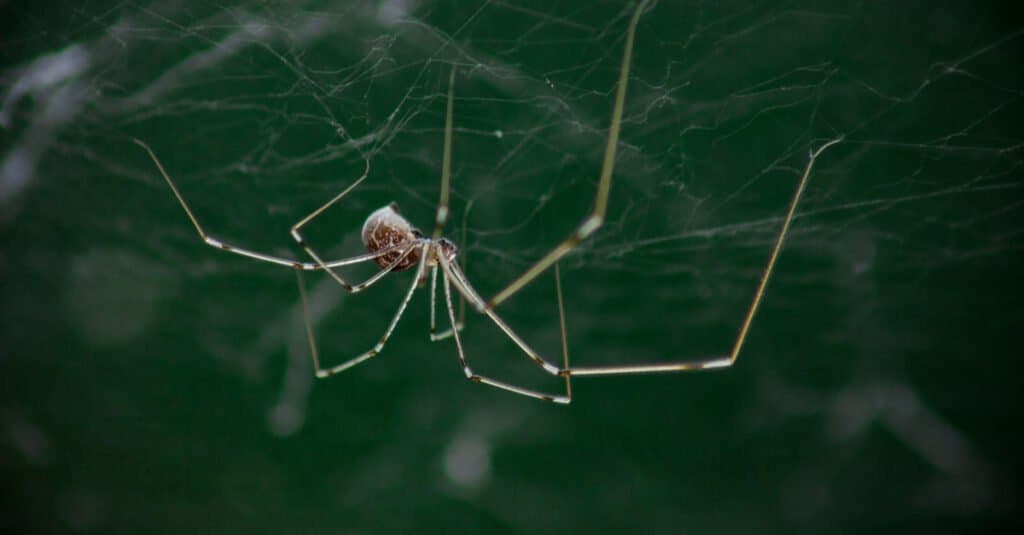
Cellar spiders live in corners of basements and cellars and blend in with their surroundings.
©CsaboPhoto/Shutterstock.com
Often referred to as “Daddy long-legs,” these spiders are known for their skinny, long legs and small bodies. They can appear gray, tan, or white and have a wispy quality that allows them to blend in with their surroundings. These common house spiders take up residence in corners in garages, basements, and cellars. Cellar spiders are not medically important because they are not known to bite people.
Southern House Spider
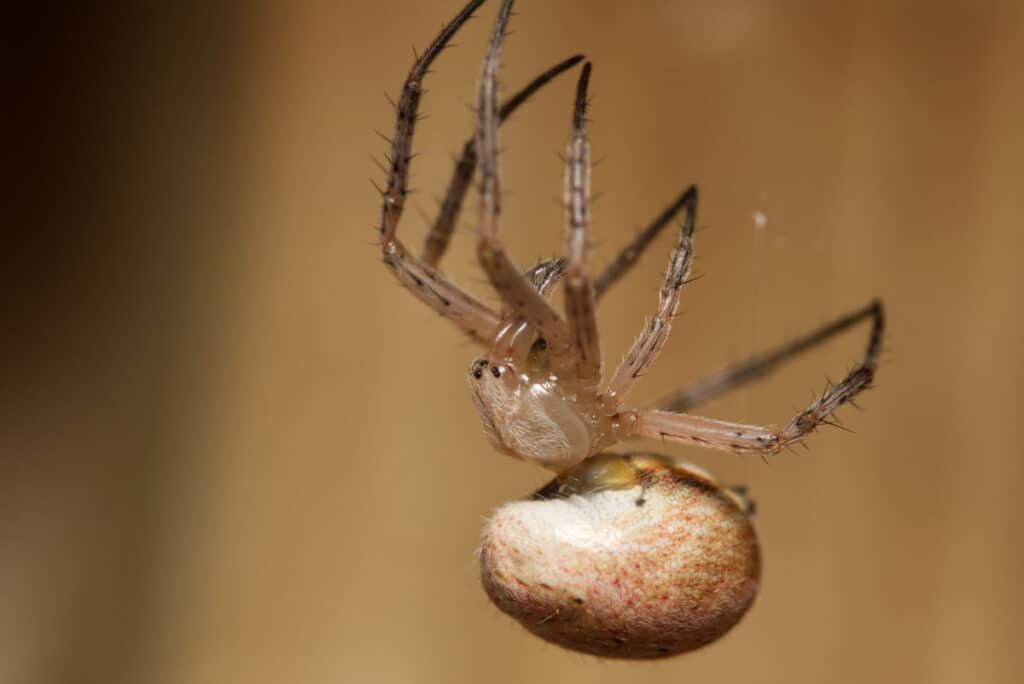
Southern house spiders often get mistaken for brown recluses due to their similar markings.
©Kala Stuwe/Shutterstock.com
This house spider is relatively big and often mistaken for a brown recluse. But southern house spiders are typically larger and lack the distinctive violin-shaped marking. Females are dark brown and more compact, and both sexes have fine, velvety hair on their abdomens. These spiders will build their webs in high places in cracks and crevices of homes, garages, and sheds.
False Black Widow
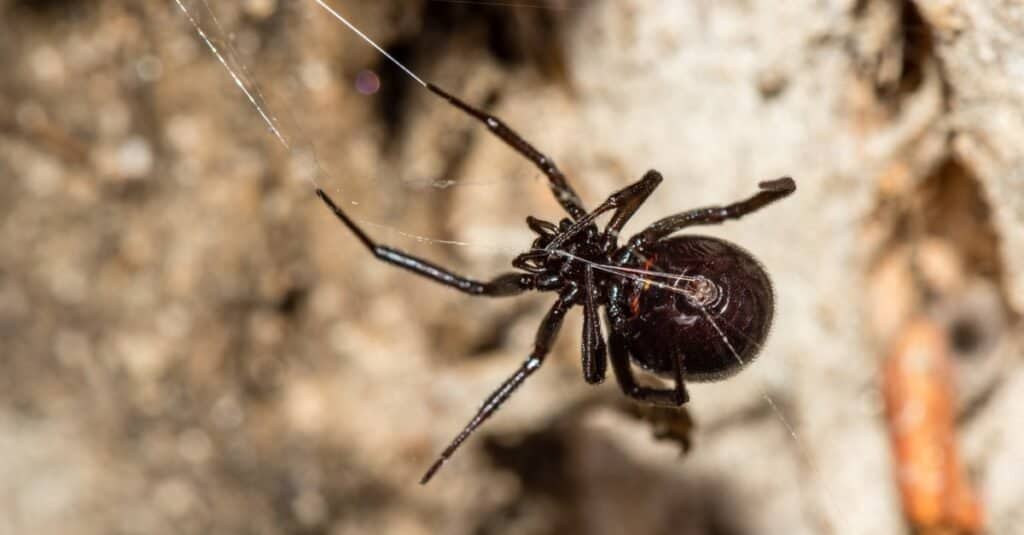
False widows
resemble black widows, but they lack the hourglass shape marking.
©Danie Spreeth Photography/Shutterstock.com
Sometimes mistaken for black widows due to their dark-colored globular bodies, false widows lack an hourglass-shaped marking or any other kinds of bright, distinctive features. This species is not aggressive towards people and will only bite when severely threatened. Symptoms from their bites don’t typically require immediate medical care but can cause fever, sweating, and muscle spasms.
Other Common Spiders in Texas
There are many other spider species in Texas; here are the most common spiders that don’t fit into a particular category.
Jumping Spiders

There are over 300 jumping spider species in the United States.
©Tran The Ngoc/Shutterstock.com
There are several jumping spider species in Texas, and it is one of the most diverse spider groups in the country (at least 300 subspecies). It gets its name from its skillful jumping abilities and can often hop around windows and doors. There are many color variations from white, yellow, gray, blue, red, or green. Their eyes are distinctive, with eight eyes in three rows and the front row has a huge middle pair.
Orb Weavers
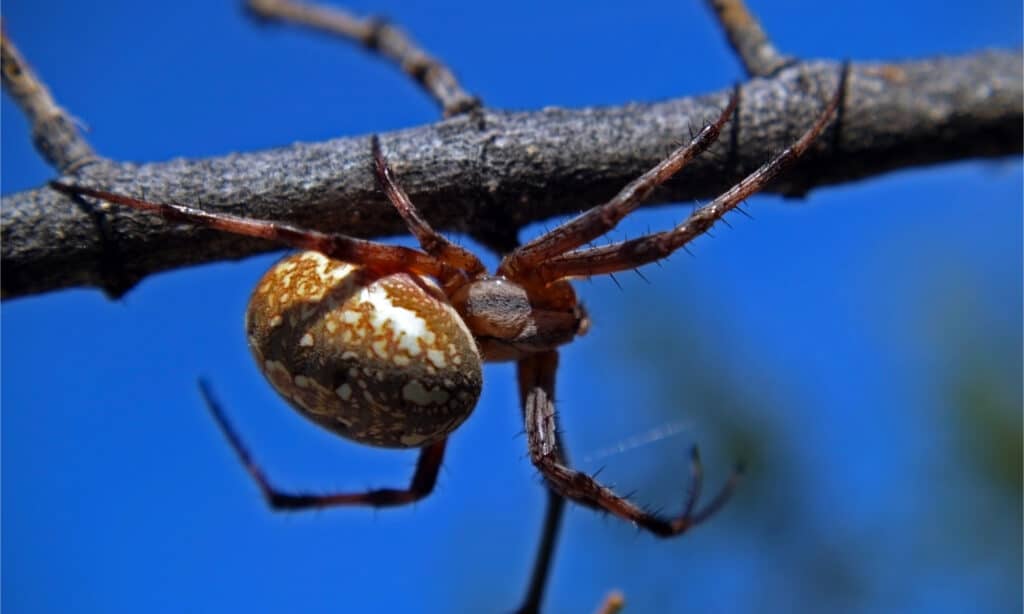
Orb weavers
inhabit fields, gardens, and forests.
©Deep Desert Photography/Shutterstock.com
Orb weavers are a group of spiders well known for being brightly colored garden spiders. There are over 3,000 species of orb weavers worldwide, and they produce spiral-shaped webs in fields, gardens, and forests. While each weaver looks different, most will have a sizeable abdomen, bright colors, and spiny legs. Orb weavers rarely bite, only when threatened, producing a mild allergic reaction similar to a bee sting.
Crab Spiders

There are 2,100 crab spider species, and they resemble crustaceans.
©HWall/Shutterstock.com
This family of spiders has over 2,100 species and are loosely considered flower spiders for their preference of sitting perched on bright flowers waiting for prey. Crab spiders resemble the crustacean and feature two larger front pairs of legs and can move backward and sideways. You will often find these spiders in backyard gardens or where there is plenty of flowers, trees, and leaf litter.
Ghost Spider
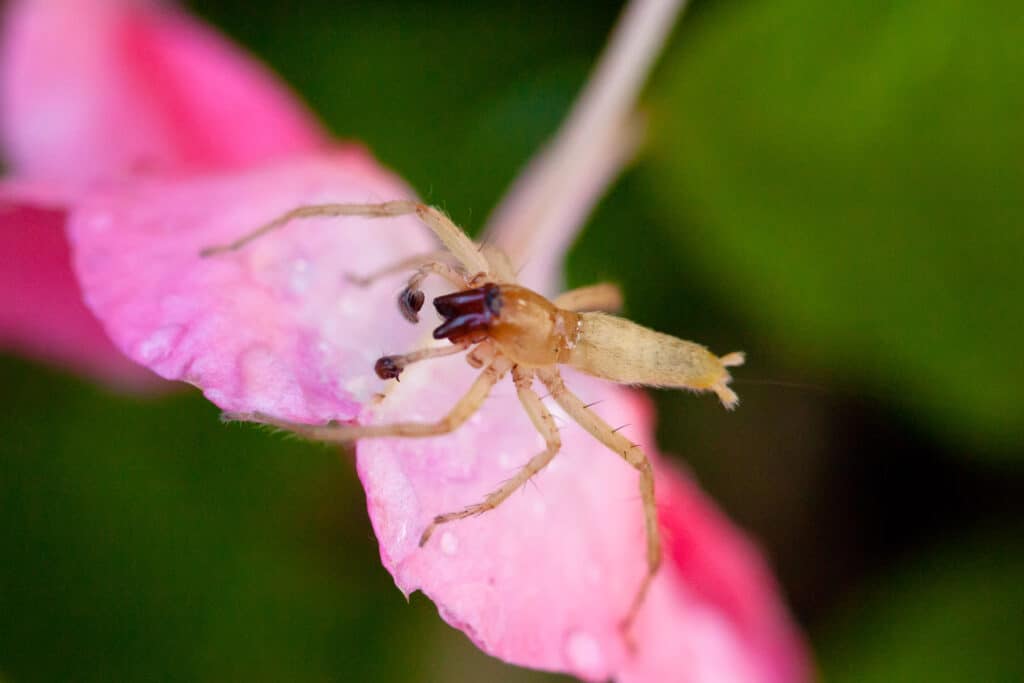
The garden ghost spider’s translucent yellowish-green body appears practically ghost-like.
Hidden by transparent silk during the day, ghost spiders are stealthy arachnids that find creative ways to stay concealed. They are also called Hibana spiders and are part of the sac spider family. These small to medium-sized spiders have a light tan body and reddish-brown legs. They hunt on the ground at night and prefer to stay hidden in the corner of a home or the backside of a leaf during the day.
Green Lynx Spider
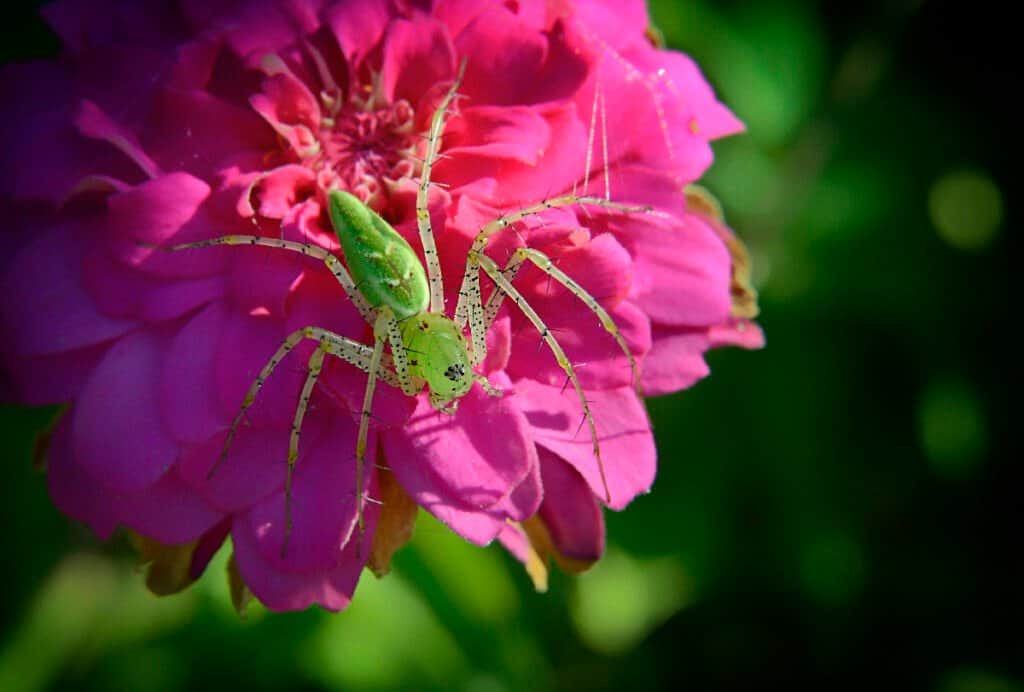
The green lynx spider blends with shrub-like plants.
©iStock.com/Lois_McCleary
This conspicuous green spider is big, bright, and often blends with shrub-like plants. Don’t be surprised if you spot this unusual-looking arachnid in your garden around low shrubs and vegetation. Before you try to get rid of it, you may want to reconsider. This species is excellent for agricultural pest management and is a friendly helper in your outdoor spaces. The green lynx is a glowing green color with a red patch between its eyes and a few red spots on its body. This species hardly ever bites humans but it can hurt when they do. However, their venom is harmless to humans.
Red Spotted Ant Mimic Spider
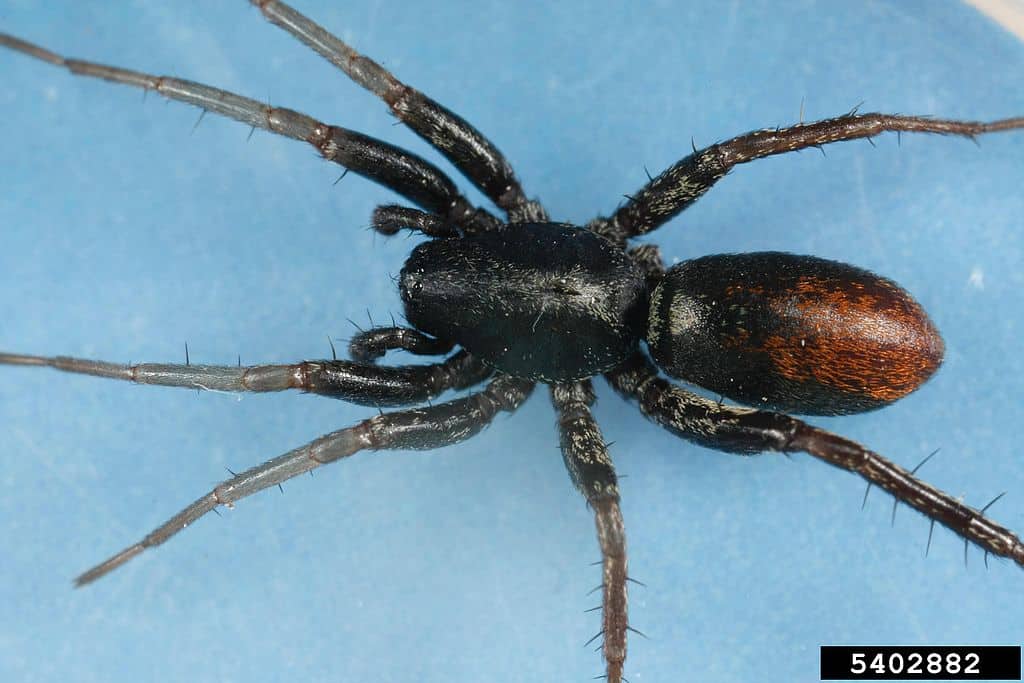
The red-spotted ant mimics an ant to sneak up on its prey.
©Joseph Berger, Bugwood.org; University of Georgia / CC BY 3.0, via Wikimedia Commons – Original / License
This spider does precisely what its name implies: it mimics an ant. It walks on its back legs and raises its front legs to appear like antennae to fool its prey and move in for an attack. Red-spotted ant mimic spiders are black with a bright red spot on their abdomen and a white line that runs down their carapace. This species inhabits many habitats, including woods, parks, and gardens.
Spitting Spider
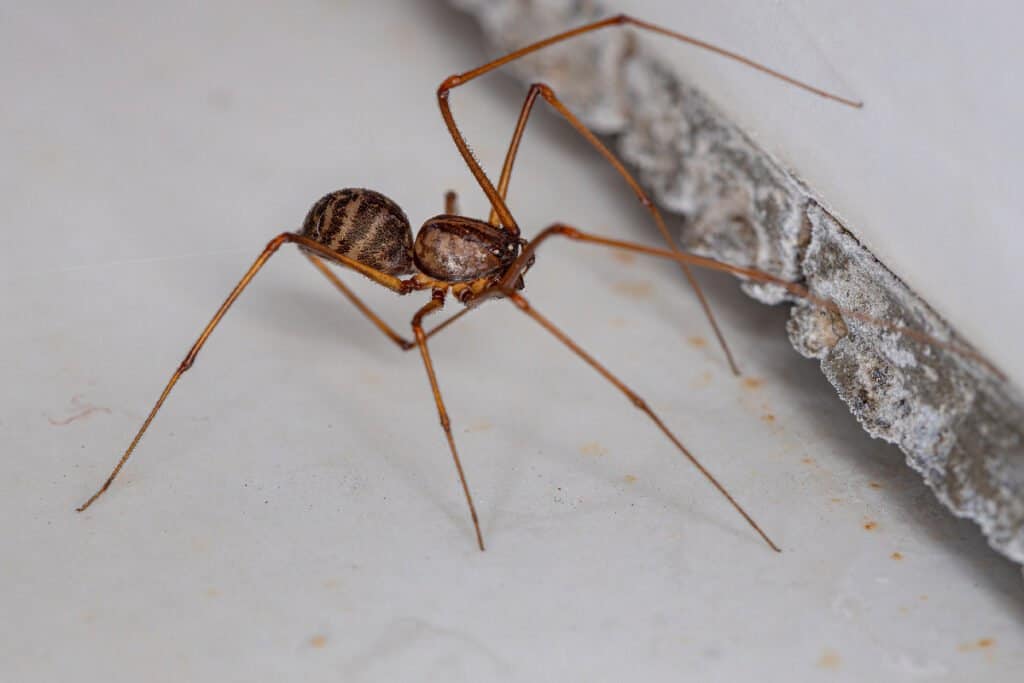
Spiders spit fluid on their victims, turning them into a congealed mass.
©iStock.com/ViniSouza128
Spitting spiders are a family of araneomorph spiders and contain over 250 species. They have six eyes arranged in three pairs and tan to light brown bodies with dark spots covering them entirely. They catch their prey by spitting fluid onto them that turns them into a congealed mass. Researchers have observed them swaying from side to side as they spit, creating a zig zag pattern more effective at immobilizing prey.
Summary of 27 Common Spiders in Texas
Here’s a recap of spiders commonly found in the state of Texas:
| Number | Spider Name | Spider Type |
|---|---|---|
| 1 | Black Widow | Venomous |
| 2 | Brown Widow | Venomous |
| 3 | Brown Recluse | Venomous |
| 4 | Northern Yellow Sac Spider | Less Venomous |
| 5 | Bold Jumping Spider | Less Venomous |
| 6 | Eastern Parson Spider | Less Venomous |
| 7 | Fishing Spider | Giant |
| 8 | Arizona Blonde Tarantula | Giant |
| 9 | Texas Brown Tarantula | Giant |
| 10 | Pantropical Huntsman | Giant |
| 11 | American Grass Spider | Giant |
| 12 | Nursery Web Spider | Giant |
| 13 | Giant Crab Spider | Giant |
| 14 | Trapdoor Spider | Giant |
| 15 | Wolf Spider | Giant |
| 16 | Hacklemesh Weaver | House |
| 17 | Common House Spider | House |
| 18 | Cellar Spider | House |
| 19 | Southern House Spider | House |
| 20 | False Black Widow | House |
| 21 | Jumping Spiders | Common |
| 22 | Orb Weavers | Common |
| 23 | Crab Spiders | Common |
| 24 | Ghost Spider | Common |
| 25 | Green Lynx Spider | Common |
| 26 | Red Spotted Ant Mimic Spider | Common |
| 27 | Spitting Spider | Common |
Bonus: What Keeps Spiders Away?

Essential oil scents like peppermint are repugnant to spiders.
©rawf8/Shutterstock.com
One of a person’s worst nightmares is having spiders wind up in their home–especially the venomous kind! The best way to avoid getting bitten by a spider is to try and prevent them from entering your house in the first place. As spiders can get into your home through holes and cracks, you can check for possible entryways with a flashlight. If the light gets through from the inside to the outside, you should fill that hole or crevice with an appropriate product.
Keeping your yard free of debris and overgrown vegetation helps cut down on areas spiders would gravitate to. Caulking doors and windows is also a good strategy to keep them out.
Spiders hate certain scents, so scented essential oils can help deter them like peppermint, tea-tree, lavender, and rose. You can add 15-20 drops of a particular oil in a water bottle mixed with water and spritz it around your house. They also hate the smell of cinnamon and vinegar, so these scents can be used similarly.
Regular cleaning inside your home, especially in areas that are dark or less frequented, is necessary to keep spiders from setting up residence. It’s also important to keep an eye on fruit bowls, as they can attract spiders.
The photo featured at the top of this post is © viktori-art/Shutterstock.com
Thank you for reading! Have some feedback for us? Contact the AZ Animals editorial team.







